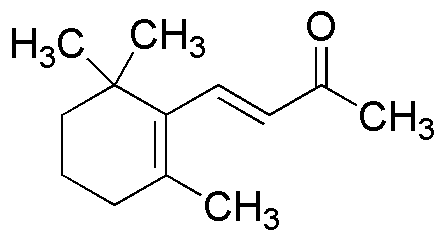b-Ionone is widely utilized in research focused on:
- Fragrance Industry: This compound is a key ingredient in perfumes and colognes, providing a floral and fruity scent that enhances the overall fragrance profile.
- Flavoring Agents: It is used in food products to impart a pleasant aroma and flavor, particularly in confectionery and beverages, making them more appealing to consumers.
- Cosmetic Formulations: b-Ionone is incorporated into skincare and cosmetic products for its aromatic properties, contributing to the sensory experience of lotions and creams.
- Pharmaceutical Applications: The compound is explored for its potential therapeutic properties, including anti-inflammatory and antioxidant effects, making it of interest in drug development.
- Aromatherapy: Used in essential oils and diffusers, b-Ionone is valued for its calming scent, which can enhance mood and promote relaxation in wellness practices.
General Information
Properties
Safety and Regulations
Applications
b-Ionone is widely utilized in research focused on:
- Fragrance Industry: This compound is a key ingredient in perfumes and colognes, providing a floral and fruity scent that enhances the overall fragrance profile.
- Flavoring Agents: It is used in food products to impart a pleasant aroma and flavor, particularly in confectionery and beverages, making them more appealing to consumers.
- Cosmetic Formulations: b-Ionone is incorporated into skincare and cosmetic products for its aromatic properties, contributing to the sensory experience of lotions and creams.
- Pharmaceutical Applications: The compound is explored for its potential therapeutic properties, including anti-inflammatory and antioxidant effects, making it of interest in drug development.
- Aromatherapy: Used in essential oils and diffusers, b-Ionone is valued for its calming scent, which can enhance mood and promote relaxation in wellness practices.
Documents
Safety Data Sheets (SDS)
The SDS provides comprehensive safety information on handling, storage, and disposal of the product.
Product Specification (PS)
The PS provides a comprehensive breakdown of the product’s properties, including chemical composition, physical state, purity, and storage requirements. It also details acceptable quality ranges and the product's intended applications.
Certificates of Analysis (COA)
Search for Certificates of Analysis (COA) by entering the products Lot Number. Lot and Batch Numbers can be found on a product’s label following the words ‘Lot’ or ‘Batch’.
*Catalog Number
*Lot Number
Certificates Of Origin (COO)
This COO confirms the country where the product was manufactured, and also details the materials and components used in it and whether it is derived from natural, synthetic, or other specific sources. This certificate may be required for customs, trade, and regulatory compliance.
*Catalog Number
*Lot Number
Safety Data Sheets (SDS)
The SDS provides comprehensive safety information on handling, storage, and disposal of the product.
DownloadProduct Specification (PS)
The PS provides a comprehensive breakdown of the product’s properties, including chemical composition, physical state, purity, and storage requirements. It also details acceptable quality ranges and the product's intended applications.
DownloadCertificates of Analysis (COA)
Search for Certificates of Analysis (COA) by entering the products Lot Number. Lot and Batch Numbers can be found on a product’s label following the words ‘Lot’ or ‘Batch’.
*Catalog Number
*Lot Number
Certificates Of Origin (COO)
This COO confirms the country where the product was manufactured, and also details the materials and components used in it and whether it is derived from natural, synthetic, or other specific sources. This certificate may be required for customs, trade, and regulatory compliance.


